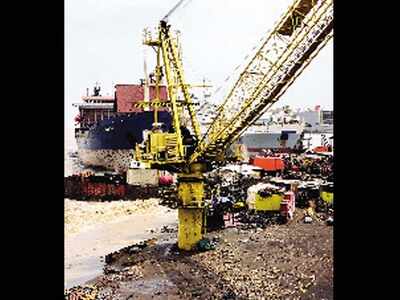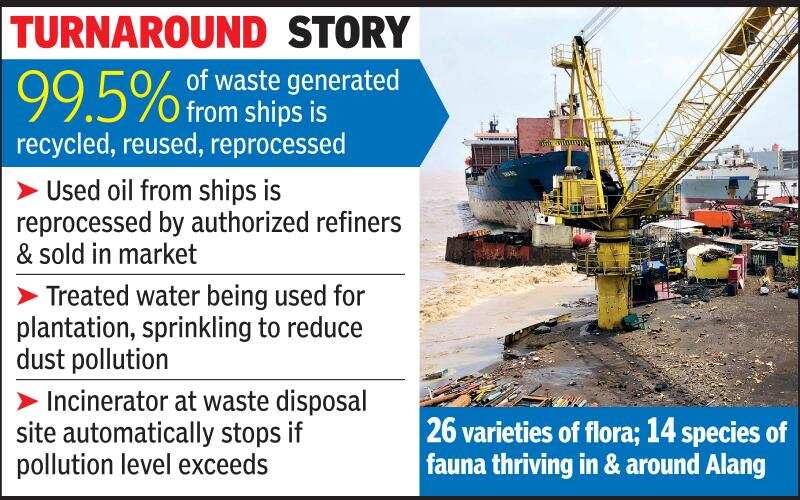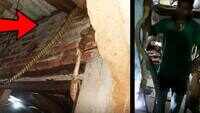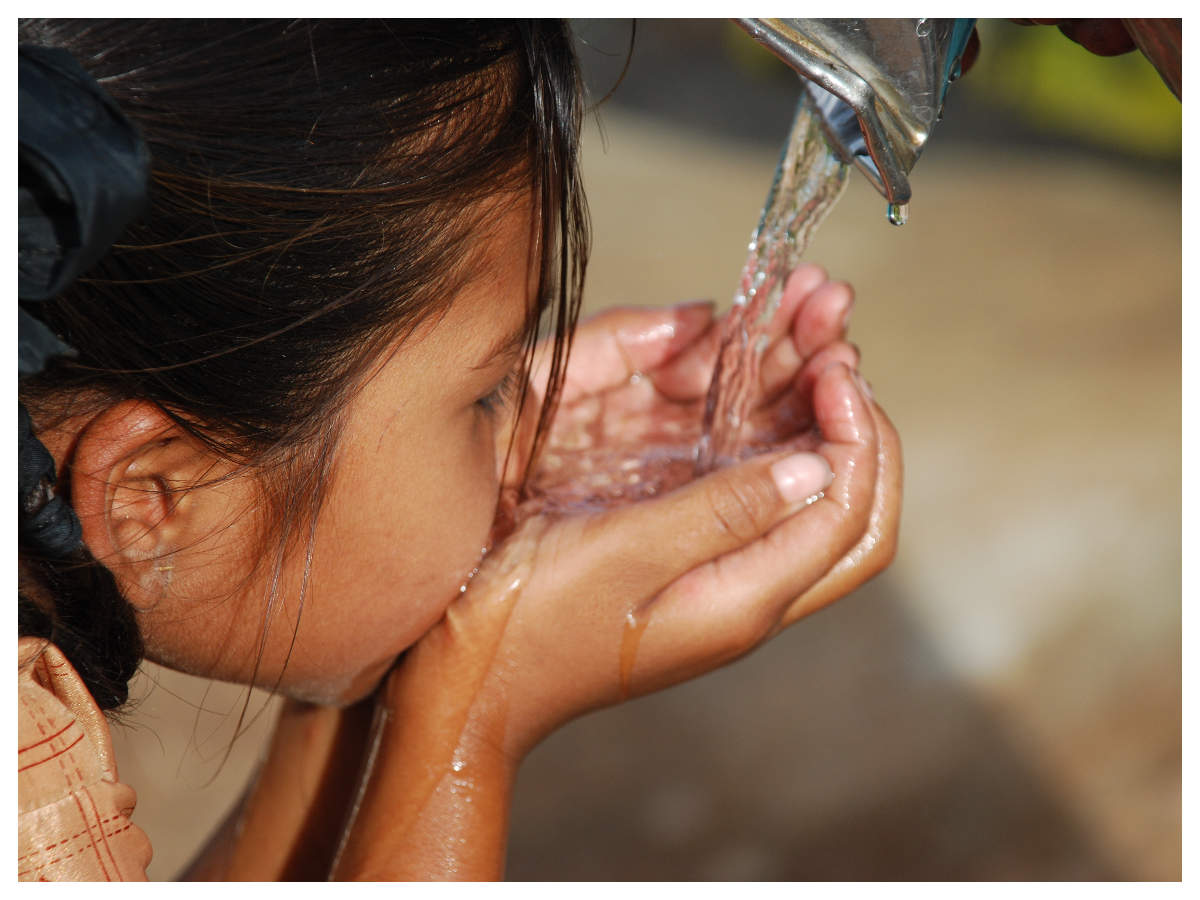
AHMEDABAD: The sneaking of a leopard into a ship beached at Alang in April was not only due to lockdown-induced minimal human movement but also a reflection of the flourishing flora and fauna in and around the world's biggest ship-breaking yards.
In fact, Alang and surrounding areas have witnessed a significant increase in the green cover over the past one decade. Data shared by Gujarat Maritime Board (GMB) shows that the green cover in and around Alang has increased by nearly 1,760 hectares from 6,990 ha in 2011 to 8,750 ha in 2020.

This roughly translates into a 10 km radius of Alang seeing a rise in vegetation, which is clearly seen in the satellite imagery of BISAG which was done as part of the environmental monitoring programme of GMB for Alang.
“Land use maps of Alang OF 2011 and 2020 clearly show that there is a rise in the vegetation area. This could be the reason for increase in wildlife diversity in the area,” a top GMB official told TOI. The leopard had made the half-dismantled ship it’s house for nearly 40 days; it went out at night and brought in preyed upon animals inside, before it was captured on May 1.
Once a favourite whipping object of environmental activists due to the deadly asbestos-laden ships, Alang has made a turnaround as far as land and air pollution is concerned.
Officials said that this is mainly attributed to much stricter ship breaking regulations as well as steps taken by the GMB to ensure that all kinds of waste emanating from the ship straight goes for scientific disposal in the five ton per day capacity Treatment Storage and Disposal Facility (TSDF) site.
“Earlier, nearly 6,000 litres of leachate (waste water from ships) used to either go into the sea or percolate the ground per day. Now, this water is sent to the hazardous waste management site, thus helping improve the groundwater quality,” said a senior environment officer at GMB.
A recent environment monitoring study titled ‘Recent Trends at Alang Ship Breaking/Recycling Yard’ done by Bhavnagar-based Central Salt & Marine Research Institute (CSMCRI) also revealed that sea, land and air pollution limits at the shipyard are below permissible limits.
Plot upgradation to reduce CO2 emission
Ahmedabad: Around 90% of steel recovered from demolished ships goes to the re-rolling mills in Bhavnagar for making bars and the process emits much less carbon compared to conventional steel manufacturing from iron ore. As a result, GMB, aided by Japan International Cooperation Agency (JICA), is in the process of upgrading the existing capacity of Alang shipyard from 4.5 million tonnes per annum to 6.5 MT. “We have reduced carbon dioxide emission by 7.34 million tonnes per year and with the upgradation, this will further increase to 10.5 MT as compared to convention steel production,” the official said.
In fact, Alang and surrounding areas have witnessed a significant increase in the green cover over the past one decade. Data shared by Gujarat Maritime Board (GMB) shows that the green cover in and around Alang has increased by nearly 1,760 hectares from 6,990 ha in 2011 to 8,750 ha in 2020.

This roughly translates into a 10 km radius of Alang seeing a rise in vegetation, which is clearly seen in the satellite imagery of BISAG which was done as part of the environmental monitoring programme of GMB for Alang.
“Land use maps of Alang OF 2011 and 2020 clearly show that there is a rise in the vegetation area. This could be the reason for increase in wildlife diversity in the area,” a top GMB official told TOI. The leopard had made the half-dismantled ship it’s house for nearly 40 days; it went out at night and brought in preyed upon animals inside, before it was captured on May 1.
Once a favourite whipping object of environmental activists due to the deadly asbestos-laden ships, Alang has made a turnaround as far as land and air pollution is concerned.
Officials said that this is mainly attributed to much stricter ship breaking regulations as well as steps taken by the GMB to ensure that all kinds of waste emanating from the ship straight goes for scientific disposal in the five ton per day capacity Treatment Storage and Disposal Facility (TSDF) site.
“Earlier, nearly 6,000 litres of leachate (waste water from ships) used to either go into the sea or percolate the ground per day. Now, this water is sent to the hazardous waste management site, thus helping improve the groundwater quality,” said a senior environment officer at GMB.
A recent environment monitoring study titled ‘Recent Trends at Alang Ship Breaking/Recycling Yard’ done by Bhavnagar-based Central Salt & Marine Research Institute (CSMCRI) also revealed that sea, land and air pollution limits at the shipyard are below permissible limits.
Plot upgradation to reduce CO2 emission
Ahmedabad: Around 90% of steel recovered from demolished ships goes to the re-rolling mills in Bhavnagar for making bars and the process emits much less carbon compared to conventional steel manufacturing from iron ore. As a result, GMB, aided by Japan International Cooperation Agency (JICA), is in the process of upgrading the existing capacity of Alang shipyard from 4.5 million tonnes per annum to 6.5 MT. “We have reduced carbon dioxide emission by 7.34 million tonnes per year and with the upgradation, this will further increase to 10.5 MT as compared to convention steel production,” the official said.

Coronavirus outbreak
Trending Topics
LATEST VIDEOS
City
 BJP leader Sonali Phogat slaps market committee secretary in Haryana’s Hisar, video goes viral
BJP leader Sonali Phogat slaps market committee secretary in Haryana’s Hisar, video goes viral  King cobra found at a house in Odisha, later rescued
King cobra found at a house in Odisha, later rescued  Deva Snana Purnima: Lord Jagannath and divine siblings bathed, dressed in elephant costumes in Odisha's Rourkela
Deva Snana Purnima: Lord Jagannath and divine siblings bathed, dressed in elephant costumes in Odisha's Rourkela  1,100 villages of Haryana to get 1.15 crore fruit-bearing, shady trees, says Haryana minister
1,100 villages of Haryana to get 1.15 crore fruit-bearing, shady trees, says Haryana minister
More from TOI
Navbharat Times
Featured Today in Travel
Quick Links
Kerala Coronavirus Helpline NumberHaryana Coronavirus Helpline NumberUP Coronavirus Helpline NumberBareilly NewsBhopal NewsCoronavirus in DelhiCoronavirus in HyderabadCoronavirus in IndiaCoronavirus symptomsCoronavirusRajasthan Coronavirus Helpline NumberAditya ThackerayShiv SenaFire in MumbaiAP Coronavirus Helpline NumberArvind KejriwalJammu Kashmir Coronavirus Helpline NumberSrinagar encounter
Get the app



